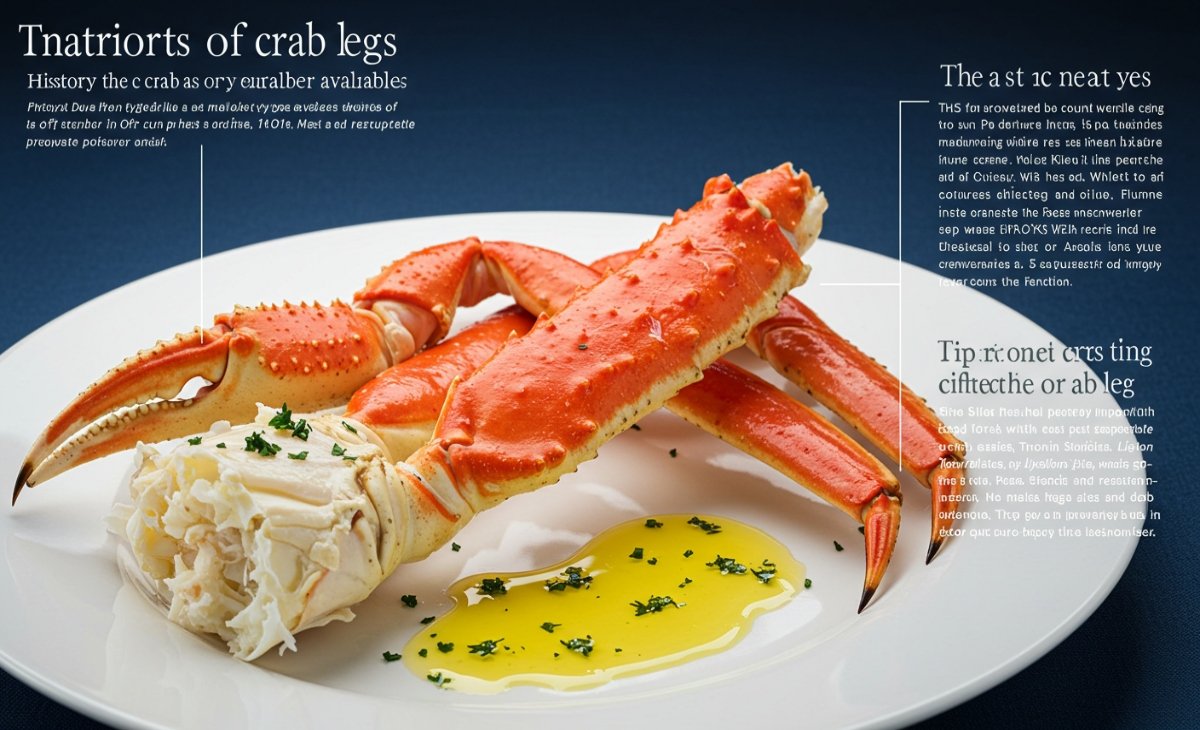Food
Crab Legs: A Luxurious Ocean Delicacy Explored

Crab legs are a luxurious seafood delicacy celebrated across cultures for their sweet, tender meat and satisfying flavor. Whether served steamed with drawn butter, featured in a seafood boil, or showcased at upscale buffets, crab legs remain one of the most coveted shellfish on the market. From their intriguing harvesting methods to nutritional benefits and preparation techniques, there’s a lot to uncover about this delicious ocean treat. This article explores the fascinating world of crab legs, offering an in-depth look at what makes them such a standout in seafood cuisine.
A Deep Dive Into the Origins of Crab Legs
Crab legs are harvested from various species of crab, but the most popular varieties include Alaskan king crab, snow crab, and Dungeness crab. Each species offers a unique flavor profile and texture, which contributes to the overall experience when enjoying crab legs. The Alaskan king crab is often considered the most prestigious, known for its massive size and succulent meat. These crustaceans are typically caught in the icy waters of the Bering Sea, and their legs can stretch to impressive lengths.
Snow crab, on the other hand, is slightly smaller but equally flavorful. Its legs are thinner and more plentiful, making it a favorite for those who enjoy working through shell after shell to reach the delicious meat inside. Dungeness crab legs are meatier and more delicate in taste, harvested mainly from the West Coast of the United States.
You Might Also Like: White Pumpkin
Harvesting and Sustainability Concerns
Harvesting crab legs is a process that requires specialized equipment and techniques. Crabs are often caught using large cages or pots that are submerged in deep waters for extended periods. These traps are designed to allow undersized crabs and non-target species to escape, which helps preserve the ecosystem.
Sustainability is a growing concern in the seafood industry, and crab leg harvesting is no exception. Overfishing, habitat destruction, and climate change are affecting crab populations worldwide. As a result, regulatory bodies have implemented strict quotas and seasonal restrictions to ensure that crab legs remain a viable food source for generations to come. These measures include limiting the number of crabs that can be caught, enforcing size limits, and monitoring the health of crab habitats.
Different Types of Crab Legs and Their Appeal
Alaskan king crab legs are prized for their incredible size and rich, buttery flavor. They are typically more expensive than other varieties due to the difficulty of harvesting them and the short fishing seasons. Their thick shells require sturdy tools for cracking, but the payoff is worth the effort. These crab legs are often featured in high-end restaurants and are a popular choice for special occasions.
Snow crab legs offer a more economical option without sacrificing taste. Their slightly briny flavor and fibrous meat make them a hit at buffets and casual seafood eateries. Snow crab legs are easier to crack open, making them a favorite for diners who enjoy a more hands-on approach without too much struggle.
Dungeness crab legs are known for their delicate sweetness and moist texture. While the legs are smaller and less meaty than those of king or snow crabs, they make up for it with a rich and nuanced flavor. These are commonly found on the West Coast and are often included in seafood boils or paired with other shellfish in stews and chowders.
Cooking Methods That Highlight Flavor
One of the reasons crab legs are so widely loved is their versatility in cooking. Steaming is a popular method that preserves the delicate flavors and natural moisture of the meat. Simply place the crab legs in a steamer basket over boiling water and heat for several minutes until warmed through.
Boiling is another traditional technique, especially common in seafood boils. This method allows the crab legs to soak up flavorful seasonings like Old Bay, garlic, lemon, and herbs. When paired with potatoes, corn, and sausage, boiled crab legs become the centerpiece of a hearty, communal meal.
Grilling crab legs adds a smoky depth to their flavor, making it a fantastic summer treat. Brush the shells with seasoned butter or olive oil, and grill them over medium heat for a few minutes per side. The result is a slightly charred exterior with juicy meat inside.
Baking crab legs is a convenient method for those who prefer minimal fuss. Place the legs on a baking sheet, brush with garlic butter or your favorite seasoning mix, and bake in the oven until heated through. This method is great for infusing the crab legs with extra flavor while retaining their tender texture.
Enhancing Crab Legs With the Right Sauces
A major part of the crab leg experience comes down to the dipping sauces. Melted butter is the classic choice, often enhanced with garlic, lemon juice, or herbs. The richness of the butter complements the sweetness of the crab meat and creates a luxurious mouthfeel.
For a spicier twist, cocktail sauce made with horseradish, ketchup, and lemon adds a bold kick. Aioli, a creamy garlic-based sauce, can also offer a sophisticated contrast to the briny crab legs. Some chefs experiment with Asian-inspired sauces like soy-ginger glaze or chili-lime dressing, offering a fusion twist on the traditional seafood treat.
Crab Legs and Nutritional Benefits
Crab legs are not just a culinary delight; they also pack a punch when it comes to nutrition. They are low in fat and calories while being high in protein, making them a smart option for those looking to maintain a healthy diet. A typical serving of crab legs provides essential nutrients such as Vitamin B12, zinc, and selenium.
Omega-3 fatty acids found in crab legs support heart health and reduce inflammation. These nutrients are particularly important for brain function and may help in preventing chronic conditions. Additionally, crab legs are a good source of phosphorus, which contributes to bone health and cellular repair.
Despite these benefits, it’s important to keep portion sizes in check, especially when crab legs are served with high-fat sauces or sides. Sodium levels can also be a concern, especially for pre-cooked or frozen varieties that are often treated with preservatives.
Crab Legs in Global Cuisine
While crab legs are especially popular in North America, they play a significant role in international cuisines as well. In Japan, crab legs are often served raw in sushi or lightly steamed as part of a kaiseki meal. Hokkaido, in particular, is famous for its snow crab and king crab dishes.
In Southeast Asia, crab legs are commonly stir-fried with aromatic spices, curry leaves, and coconut milk. These flavorful dishes showcase the adaptability of crab legs in bold and vibrant cooking styles. In France, crab legs may appear in delicate bisques or paired with butter-poached vegetables for a refined presentation.
In the southern United States, crab legs are a key ingredient in Cajun and Creole cooking. Seafood boils, gumbo, and étouffée often feature crab legs, lending their rich flavor to the dish. These hearty meals reflect the communal and celebratory nature of eating crab legs.
Choosing and Storing Crab Legs
Buying fresh crab legs can be a challenge, depending on your location. If you’re near the coast, fresh options from local fishmongers are ideal. Look for firm, moist meat with a clean ocean scent. For frozen crab legs, select packages with no signs of freezer burn or excessive ice crystals.
Once you have your crab legs, proper storage is essential to maintain quality. Fresh crab legs should be stored in the coldest part of your refrigerator and consumed within two days. Frozen crab legs can be kept for several months, but it’s best to use them within three to six months for optimal taste.
To thaw frozen crab legs, place them in the refrigerator overnight. Avoid using hot water or a microwave to speed up the process, as this can alter the texture and diminish the flavor. Once thawed, crab legs should be cooked and served promptly.
Dining Etiquette and Serving Tips
Crab legs are typically eaten with hands, which adds to their communal and interactive appeal. Crab crackers, seafood forks, and mallets can make the experience easier and less messy. Provide napkins, wet wipes, and finger bowls if you’re serving crab legs at a formal event or dinner party.
When serving crab legs, consider pairing them with sides that balance their richness. Garlic mashed potatoes, grilled asparagus, buttered corn, or a fresh green salad can all complement the flavor profile. For beverages, crisp white wines like Chardonnay or Sauvignon Blanc are excellent choices. Beer lovers may enjoy pairing crab legs with a light lager or wheat beer to cleanse the palate between bites.
Crab Legs as a Luxury Experience
Crab legs have long been associated with indulgence and celebration. Whether it’s a holiday feast, a romantic dinner, or a high-end buffet, they add an element of sophistication to any occasion. Their status as a premium seafood item means they are often reserved for special moments, adding to their allure.
The process of cracking, dipping, and savoring crab legs encourages diners to slow down and appreciate the meal. In a world where fast food dominates, crab legs offer a reminder of the joys of shared, thoughtful dining.
The Future of Crab Legs in the Culinary World
As culinary tastes evolve, so too does the appreciation for crab legs. Chefs are experimenting with new flavor profiles and presentation styles to bring crab legs into contemporary cuisine. From fusion dishes to sustainable sourcing practices, the industry is adapting to modern demands while preserving the integrity of this beloved seafood.
Efforts to farm crabs in controlled environments may also shape the future of crab legs, potentially making them more accessible and reducing the pressure on wild populations. Innovations in preservation and packaging are improving the quality of frozen crab legs, offering consumers a near-fresh experience year-round.
A Timeless Seafood Treasure
Crab legs continue to captivate food lovers with their tender meat, rich flavor, and elegant appeal. Whether you’re indulging in a five-star seafood dinner or hosting a casual backyard boil, crab legs elevate the meal to something memorable. Their blend of tradition, luxury, and global influence ensures that they will remain a treasured delicacy for years to come.

 Blog5 months ago
Blog5 months ago[PPT] Human Reproduction Class 12 Notes
- Blog5 months ago
Contribution of Indian Phycologists (4 Famous Algologist)
- Blog5 months ago
PG TRB Botany Study Material PDF Free Download

 Blog5 months ago
Blog5 months agoCell The Unit of Life Complete Notes | Class 11 & NEET Free Notes

 Blog5 months ago
Blog5 months ago[PPT] The living world Class 11 Notes

 Entertainment5 months ago
Entertainment5 months agoIbomma Bappam: Redefines Telugu Streaming Trend
- Blog5 months ago
Class 12 Biology Notes Chapter wise PPT

 Blog5 months ago
Blog5 months agoClassification of Algae By Fritsch (11 Classes of Algae)












